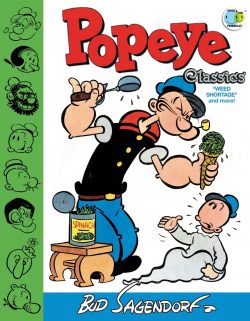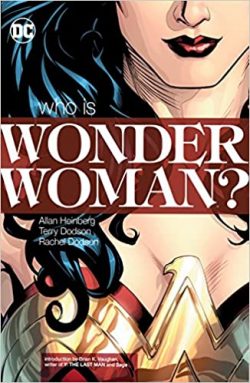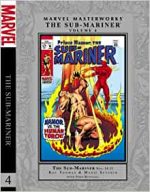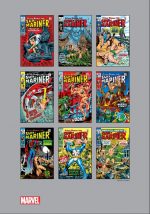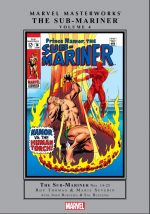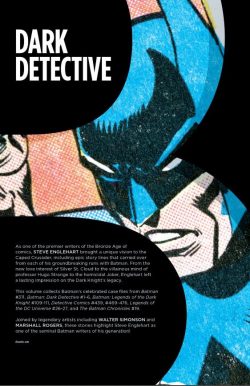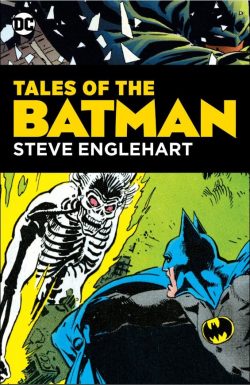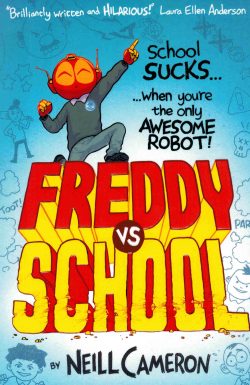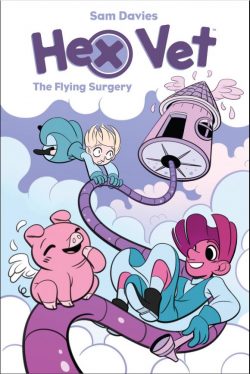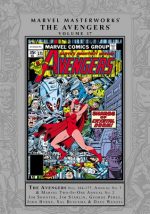
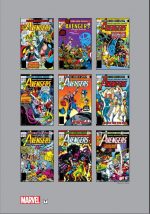
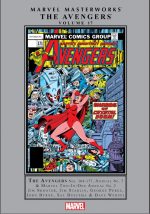
By Jim Shooter, Jim Starlin, Roger Stern, Marv Wolfman, George Pérez, David Michelinie, Bill Mantlo, Mark Gruenwald, Sal Buscema, Dave Wenzel, Tom Morgan & various (Marvel)
ISBN: 978-1302903411 (HB)
The Avengers have always proved that putting all one’s star eggs in a single basket pays off big-time: even when all Marvel’s classic all-stars such as Thor, Captain America and Iron Man are absent, it merely allows the team’s lesser lights to shine more brightly.
Of course, all the founding stars were regularly featured due to the rotating, open door policy, which means that every issue includes somebody’s fave-rave – and the boldly grand-scale impressive stories and artwork are no hindrance either. With the team now global icons, let’s look again at the stories which form the foundation of that pre-eminence.
Re-presenting Avengers #164-177, Avengers Annual #7 plus the concluding half of the legendary crossover epic from Marvel Two-in-One Annual #2 (cumulatively spanning October 1977 to November 1978), these stories again see the team in transition and against the biggest threats ever imagined.
During this period Jim Shooter, having galvanised and steadied the company’s notional flagship, moved on, leaving David Michelinie to impress his own ideas and personality upon the team, even as Cosmic Doomsmith Jim Starlin recruited the team to inscribe an epic ending to his seminal interpretation of tragic antihero Adam Warlock…
Opening this titanic tome is an informative Foreword from scripter Roger Stern, followed by a stunning 3-part saga by Shooter, John Byrne & Pablo Marcos which reinvented one of the team’s oldest adversaries.
It begins in #164 as, after months of speculation and experimentation, the resurrected Wonder Man is finally revealed to have evolved into a creature of pure ionic energy. Elsewhere, aging Maggia Don Count Nefaria recruits Whirlwind, Power Man (the original mercenary who had undergone the same transformative experiment as Wonder Man) and Living Laser to amass plunder for him. This tactic is mere subterfuge…
After the thieves trash a squad of Avengers, Nefaria uses his flunkies’ bodies as templates and power source to turn himself into a literal Superman before attacking the already-battered heroes in ‘To Fall by Treachery!’
The tension builds in #165 as ‘Hammer of Vengeance’ sees the out-powered team fall, only to be saved by elderly speedster The Whizzer who points out that, for all his incredible strength, Nefaria too is an old man with death inevitably dogging his heels…
Panicked and galvanised, the Overman goes berserk, carving a swathe of destruction through the city whilst seeking a confrontation with Thunder God Thor and the secret of his immortality. Before too long he had reason to regret his demands. The surprise arrival of the Thunderer in ‘Day of the Godslayer!’ ends the madman’s dreams but also highlights growing tensions within the victorious team…
This superb thriller is followed by ‘The Final Threat’ (Jim Starlin & Joe Rubinstein) from Avengers Annual #7, wherein Kree warrior Captain Marvel and Titanian mind-goddess Moondragon return to Earth with vague anticipations of an impending cosmic catastrophe.
Their premonitions are confirmed when galactic wanderer Adam Warlock arrives with news that death-obsessed Thanos has amassed an alien armada and built a Soul-gem powered weapon to snuff out the stars like candles…
Broaching interstellar space to stop the scheme, the united heroes forestall the stellar invasion and prevent the Dark Titan from destroying the Sun, but only at the cost of Warlock’s life…
Then ‘Death Watch!’ (Starlin & Rubinstein from Marvel Two-in-One Annual #2) finds Peter Parker plagued by prophetic nightmares, disclosing how Thanos had snatched victory from defeat and now holds the Avengers captive whilst again preparing to extinguish Sol.
With nowhere else to turn, the anguished, disbelieving Spider-Man heads for the Baxter Building, hoping to borrow a spacecraft, unaware that The Thing also has history with the terrifying Titan.
Although utterly overmatched, the mismatched champions of Life subsequently upset Thanos’ plans enough so that the Avengers and the Universe’s true agent of retribution can end the Titan’s threat forever… or at least until next time…
Back in the monthly, an epic of equal import was about to unfold. Shooter’s connection to the series, although episodic, was long-lived and produced some of that period’s greatest tales, none more so than the stellar – if deadline-doomed – saga which occurred over succeeding months: a sprawling tale of time-travel and universal conquest which began in Avengers #167-168 and, after a brief pause, resumed for #170 through #177.
In previous issues a difference of opinion between Captain America and Iron Man over leadership styles had begun to polarise the team. Cracks appeared and tensions started to show in #167 with ‘Tomorrow Dies Today!’ (Shooter, George Pérez & Marcos).
In the Gods-&-Monsters filled Marvel Universe there are entrenched and jealous Hierarchies of Power, so when a new player mysteriously materialises in the 20th century the very Fabric of Reality is threatened…
It kicks off when star-spanning 31st century superheroes the Guardians of the Galaxy materialise in Earth orbit, hotly pursuing cyborg despot Korvac. Inadvertently setting off planetary incursion alarms, their minor-moon sized ship is swiftly penetrated by an Avengers squad, and – after the customary introductory squabble – the future men (Charlie-27, Yondu, Martinex, Nikki, Vance Astro and enigmatic space God Starhawk) explain the purpose of their mission…
Captain America had fought beside them to liberate their home era from Badoon rule and Thor battled the fugitive Korvac before, so peace soon breaks out, but even with the resources of Earth’s Mightiest Heroes, the time travellers are unable to find their quarry…
Meanwhile on Earth, a mysterious being named Michael lurks in the background. At a fashion show staged by the Wasp, he achieves a psychic communion with model Carina Walters before they both vanish…
‘First Blood’ (Avengers #168) stirs up more trouble as Federal liaison and hidebound martinet Henry Peter Gyrich begins making life bureaucratically hot for the maverick team. In Colorado, meanwhile, Hawkeye gets a shock as his travelling partner Two-Gun Kid vanishes before his eyes whilst in suburban Forest Hills, Starhawk – in his female iteration of Aleta – approaches a quiet residence…
Michael/Korvac’s plan consists of subtly altering events as he gathers strength in secret preparation for a sneak attack on those aforementioned Cosmic Hierarchies. His entire plan revolves around not being noticed. When Starhawk confronts him, the villain kills the stellar intruder and instantly resurrects him minus the ability to perceive Michael or any of his works…
The drama screeches to a halt in #169, which declares ‘If We Should Fail… The World Dies Tonight!’ The out of context potboiler – by Marv Wolfman, Sal Buscema & Dave Hunt – sees Cap, Iron Man and the Black Panther scour the planet in search of doomsday bombs wired to the failing heart of a dying man, after which the major mayhem resumes in #170 with ‘…Though Hell Should Bar the Way!’ by Shooter, Pérez & Marcos.
As Sentinel of Liberty and Golden Avenger finally settle their differences, in Inhuman city Attilan, ex-Avenger Quicksilver suddenly disappears even as dormant mechanoid Jocasta (designed by maniac AI Ultron to be his bride) goes on a rampage before vanishing into the wilds of New York City.
In stealthy pursuit and hoping her trail will lead to Ultron himself, the team stride into a trap ‘…Where Angels Fear to Tread’ but nevertheless triumph thanks to the hex powers of the Scarlet Witch, the assistance of pushy, no-nonsense new hero Ms. Marvel and Jocasta’s own rebellion against the metal monster who made her. However, at their moment of triumph the Avengers are stunned to see Cap and Jocasta wink out of existence…
The problems pile up in #172 as Watchdog-come-Gadfly Gyrich is roughly manhandled and captured by out-of-the-loop returnee Hawkeye and responds by rescinding the team’s Federal clearances.
Badly handicapped, the heroes are unable to warn other inactive members of the increasing disappearances even as a squad of heavy hitters rush off to tackle marauding Atlantean maverick Tyrak the Treacherous who is bloodily enacting a ‘Holocaust in New York Harbor!’ (by Shooter, Sal Buscema & Klaus Janson)…
Answers to the growing mystery are finally forthcoming in ‘Threshold of Oblivion!’, plotted by Shooter, with David Michelinie scripting for Sal Buscema & D(iverse) Hands to illustrate.
As the vanishings escalate, the remaining Avengers (Thor, Wasp, Hawkeye and Iron Man – with the assistance of Vance Astro) finally track down their hidden foe and beam into a cloaked starship to liberate the ‘Captives of the Collector!’(Shooter, Bill Mantlo, Dave Wenzel & Marcos)…
After a staggering struggle, the heroes triumph and their old foe reveals the shocking truth: he is in fact an Elder of the Universe who foresaw cosmic doom millennia previously and sought to preserve special artefacts and creatures – such as the Avengers – from the slowly approaching apocalypse.
As he reveals that predicted end-time is here and that he has sent his own daughter Carina to infiltrate the Enemy’s stronghold, the cosmic curator is obliterated in a devastating blast of energy. The damage however is done and the entrenched hierarchies of creation may well be alerted…
Issue #175 began the final countdown as ‘The End… and Beginning!’ (Shooter, Michelinie, Wenzel & Marcos) sees the amassed and liberated ranks of Avengers and Guardians follow the clues to Michael, just as the new god shares the incredible secret of his apotheosis with Carina, before ‘The Destiny Hunt!’ and ‘The Hope… and the Slaughter!’ (Shooter, Wenzel, Marcos & Ricardo Villamonte) depicts the entire army of champions destroyed and resurrected as Michael easily overpowers all opposition but falters for lack of one fundamental failing…
Spread through a series of lesser adventures, the overarching epic ponderously and ominously unfolds before finally exploding into a devastating and tragic Battle Royale that is the epitome of superhero comics. This is pure escapist fantasy at its finest.
Despite being somewhat diminished by the artwork when the magnificent Pérez gave way to less inspired hands and cursed by the inability to keep a regular inker (Pablo Marcos, Klaus Janson Ricardo Villamonte and Tom Morgan all pitched in), the sheer scope of the epic plot nevertheless carries this story through to its cataclysmic and fulfilling conclusion.
Even Shooter’s reluctant replacement by scripters Dave Michelinie and Bill Mantlo (as his editorial career advanced) couldn’t derail this juggernaut of adventure.
If you want to see what makes Superhero fiction work, and can keep track of nearly two dozen flamboyant characters, this is a fine example of how to make such an unwieldy proposition easily accessible to the new and returning reader.
Available in hardback and digital iterations, and supplemented by original cover art by Pérez and Dave Cockrum, contemporary House Ads, editorial material and covers from previous compilations plus an epilogue strip by Mark Gruenwald & Tom Morgan, this archival tome and this type of heroic adventure might not be to every reader’s taste but these – and the truly epic yarns that followed – set the tone for fantastic Fights ‘n’ Tights dramas for decades to come and informed all those movies everybody loves. This tale can still boggle the mind and take the breath away, even here in the quietly isolated and no less dangerous 21st century…
No lovers of Costumed Dramas can afford to ignore this superbly bombastic book, and fans who think themselves above superhero stories might also be pleasantly surprised…
© 2017 Marvel Characters, Inc. All rights reserved.


